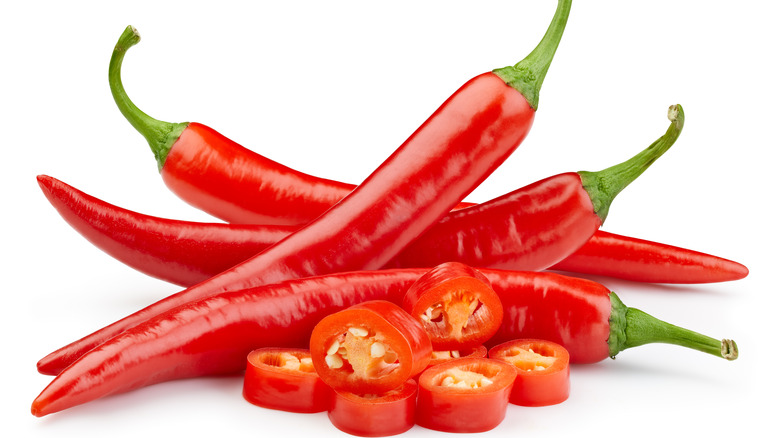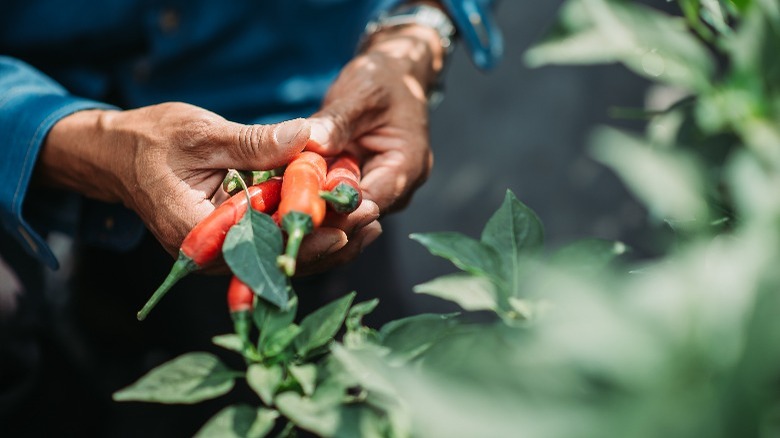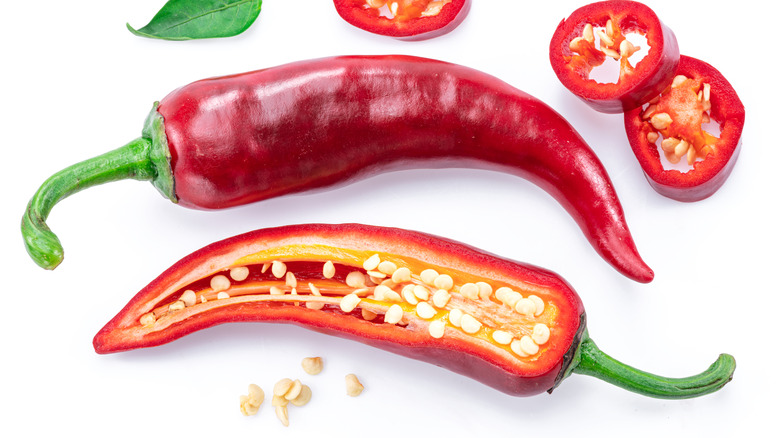How To Actually Cut The Spice Out Of A Pepper (Hint: It's Not All In The Seeds)
Spicy peppers are a joy for some but a literal pain for others. Sometimes, you just need to cut out the heat or at least dial it down a bit so you can keep your tongue from burning off. It's a common tip that cutting the seeds out of hot peppers will remove the spiciness, but the truth is that the real source of the heat is from the placenta, or pith, the soft, white membrane that lines the inside of the pepper just below the stem. There resides most of the pepper's capsaicin, the chemical compound that gives the chili its signature kick.
The placenta connects to the capsaicin glands, which is the rib that runs through the pepper from top to bottom. Since the seeds hang off this section, many assume that plucking the seeds will remove the heat. That's probably because removing the seeds often dictates slicing or peeling the entire placental structure out to make the process easier, which means the capsaicin glands are often taken out, as well. If you want proof, simply poke a seed off of a chili pepper and taste it. You might feel a tinge of spice since it's been hanging next to the pith, but an actual bite out of the membrane will set your mouth ablaze.
A course on capsaicin
Capsaicin is, in fact, technically toxic, though it's completely non-life-threatening. The chemical is a self-defense mechanism for certain plants belonging to the genus capsicim, or, you know, peppers. The fiery, stinging pain that capsaicin causes when it comes into contact with nerve endings is meant to deter animals and fungus from feasting. However, it has just encouraged humans to indulge even further. Spiciness may feel exhilarating to taste, but it's important to always wear gloves when handling hot peppers, especially when removing the seeds and pith, since this chemical reaction occurs on the skin, too. It's not nearly as pleasant when your hands are burning, and even less so when you accidentally rub your eyes after touching a chili.
Like the spiciness it causes, capsaicin is a point of human fascination. Ironically, some use topical capsaicin cream as a pain reliever to combat nerve damage since the numbing and tingling sensation it causes can feel like it dampens the hurt. Very recently, the Nobel Prize for Physiology and Medicine in 2021 was awarded to scientists who discovered the TRPV1 gene that holds the capsaicin receptors, broadening an understanding of how the skin feels and perceived temperatures.
How to turn down the spice of a chili pepper
There are two main ways to deseed and remove the placenta membrane from a chili pepper. In both methods, it's easier to cut the stem off first before doing anything else. From here, you can cut the pepper down the middle into two halves and carve out the pithy parts using a spoon you can scrape down the sides. Be careful not to get any pepper juice in your eyes. In fact, if that's something you're worrying about, it may help to keep the pepper intact after popping off the stem and use the spoon to scoop everything out, similar to carving out a pumpkin or squash.
Both methods are acceptable, though the latter does offer more flexibility for a recipe. If you need to chop up the pepper, then it doesn't matter how you mangle the chili. However, you may not want to slice the chili in half if you want to make a stuffed pepper recipe, such as the hearty chile relleno. Keep in mind that the hotter the pepper, the larger the placenta membrane will be, and always remember that simply shaking the seeds out alone won't make the hot pepper any less spicy.



